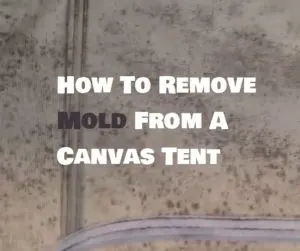 Learning how to remove mold from canvas tents is an essential skill all campers must obtain. Mold is an annoying part of everyday life as it can practically get into everything. When it comes to camping, it can be even more frustrating as mold can quickly ruin expensive things like tents made with high-quality canvas.
Learning how to remove mold from canvas tents is an essential skill all campers must obtain. Mold is an annoying part of everyday life as it can practically get into everything. When it comes to camping, it can be even more frustrating as mold can quickly ruin expensive things like tents made with high-quality canvas.
Canvas tents are more expensive because they are so durable and long-lasting, but mold is one surefire way to shorten the lifespan of the tent. When you’re the proud owner of a canvas tent, you should learn not only how to remove, but also how to prevent mold from occurring in the first place.
Finding mold on your canvas tent is not something you expect to see once you unpack it after a long winter break, and more often than not, it will rot your tent and end up costing you a lot of money. Not the best way to get the camping season underway.
So you can see why taking preventative steps to ensure you don’t discover mold is so important, especially after you have spent all those hard-earned dollars on a premium grade canvas tent.
But if you do discover that your tents have started growing mold, the good news is that unless you have an allergy to mold, it’s not typically dangerous upon initial contact. Tho it’s not something I’d recommend breathing in or living in close proximity to for long periods of time. There’s just something about mold and how it destroys most things it’s on that makes me not want to be near it.
The easiest way to stop mold is to try and prevent it all together as this will mean you won’t have to get rid of it. So with that said, let’s have a look at how to remove mold from a canvas tent — followed by ways to prevent it in the future!
How To Remove Mold From Canvas Material
As I briefly touched on, the best way to get rid of mold from forming on your canvas tent is to prevent it before it even starts. But for many people, it’s too late and the mold has already set in.
Here are the steps to remove mold from your canvas tent.
Step 1. Identify The Mold Damage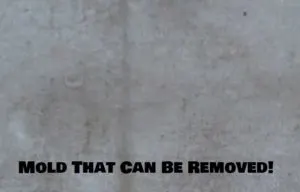
The first step is to identify how much mold exists and how much damage has already occurred. If the tent has holes where there are visible signs of mold, then I’ve got some bad news for you. The mold has gone too far to remove and deteriorated the material.
At this point, you will need to asses the damage and decide whether its time to get a new tent, or simply repair your existing tent. If there’s not too much damage caused, you could always sew in a new patch of canvas material over the existing holes once you remove the mold.
If there are only a few speckles of the mold with no visible holes or tears present in the canvas, then you’re in with a fighting chance.
Now that you’ve identified the mold, your next step is to kill the mold. There are several ways you can kill mold with the most straightforward being – using white vinegar that has been watered down.
In a spray bottle, mix up a solution of water and white vinegar (2 parts vinegar, 1 part water) and spray on the affected areas of the tent. You should then let the parts you’ve sprayed to dry before moving onto the next step.
Pro-Tip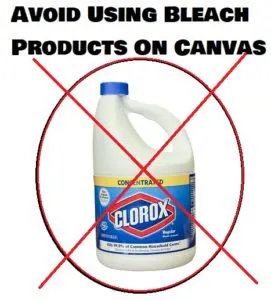
- Side note, some people may suggest using bleach to get rid of mold. I believe you should not do this on a canvas tent or almost any tent, as bleach can eat the coating of waterproofing from your tent. In some cases, bleach has even been known to eat the fabric of your tent. For me, this is enough of a warning not to use bleach on my tent, ever.
Step 2 – Combine Warm Water, Lemon & Salt
Now that your tent has dried, you need to gather a few household items such as warm water, lemon, and some salt. Some people say hot water, but hot water can also ruin your tent’s waterproofing as well. You should give this a very light wiping as scrubbing leads to wrecking your waterproofing as well. Then let it dry out again.
After you follow these two simple steps, it should be enough to help get rid of the traces of mold. It’s essential to pay particular attention to letting the canvas dry between steps as moisture is what causes mold. No need to add insult to injury by not allowing the canvas material completely dry before adding additional moisture.
Step 3 – Apply Waterproofing Spray
The next step would be to put another coat of waterproofing on your tent as there’s a very good chance the mold has eaten into your protection. The last thing you want is for the canvas to become wet again and possibly flood your tent the next time it rains.
Pro-Tip
One more tip that should go without saying, but you just never know, is to do this whole mold removal process outside of the home. The last thing you want to do is clean mold from your tent inside your house as this could let the spores jump from the canvas to other items of furniture and spread the mold even further. So while this should go without saying there’s a reason they say common sense isn’t common.
Best Mildew Stain Remover For Canvas
Sometimes using the simple steps above with the combination of lemon, salt, and warm water isn’t enough to clean your canvas tent of the mold it has. Once you have tried the above steps and it’s not looking much better, chances are you may need a heavy-duty mold and mildew remover.
Something like this Star Brite mildew stain remover is a product that is commonly used with tents like the Springbar and Kodiak canvas tents. It can be used as the complete all in one solution or as a secondary phase for tough, stubborn stains. A heavy-duty solution like the Star Brite is a great alternative to get rid of mold when it’s more stubborn than usual.
The best thing about this mildew remover is that it doesn’t require heavy scrubbing to remove the mold. Heavy scrubbing on a canvas tent can and will destroy your waterproofing if not done carefully. Since you’ll have to buy more waterproofing and apply it yourself, it can become quite an expensive mold removal process.
It’s one of the few mildew removers that can be used on a canvas tent, which is why I like it so much. Finding something that can be used on canvas and doesn’t destroy the structure of the material is challenging. These reasons alone are why so many people recommend this for getting rid of mold on a canvas tent.
While I will still stand by trying to prevent mold in the first place, there are times when they are needed. So its always a good practice to have a bottle or two of the Star Brite laying around your shed or garage if you own a canvas tent.

How To Prevent Mold Growing On Canvas Tent
Now that you know how to clean mold from your canvas tent, the next step is to prevent it from ever happening, which is something you can do every time you get back from camping. Preventing mold is very simple to do, and once you learn how to avoid it, the need for mold cleaning products will no longer be valid.
When you first get back from camping, you should clean out your tent by shaking any debris out of it and either giving it a light wipe down or washing it down with water. Just remember that you shouldn’t use a high-pressure washer to wash a canvas tent. For the best results in cleaning, you want to emulate rain.
Now you’ve cleaned your tent comes what I consider the essential steps in preventing mold. Start by drying/airing your tent out by setting it up on your driveway or back deck, just make sure it’s not on grass as grass holds a lot of moisture, which can be spread to your tent. Now your tent is dry, you want to store it in a cool, dry area that doesn’t get a lot of humidity as that can cause mold.
How To Store A Canvas Tent Once Mold Has Been Removed 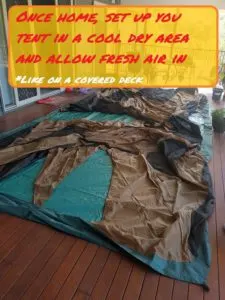
Now that you’ve removed the mold from your canvas tent, the next step is to store your tent correctly, so you don’t get a nasty surprise on your next camping trip. The first thing that you should do after your camping trip is to let your tent dry and air out. Even if there was no rain during your camp, as condensation and moisture in the air do get caught up in the tents tightly nit materials. Even the smallest amount of moisture can lead to mold growing on your canvas.
Moisture can build up on the bottom of your tent even if you think you were in conditions that wouldn’t allow for it. This is in part because you set your tent up on the grass. Since grass can hold a lot of moisture, this moisture can be passed into the floor of your tent. I think it’s better to be safe than sorry in this case.
Drying out your tent is essential, and there are several ways you can do it. Setting the tent up in a cool, sheltered, dry area is one way of doing it as you can let the tent dry out for a longer period of time without fear of rain wetting the tent.
Leaving in the sun isn’t a bad idea also as the sun can help fight off mildew and quickly dry any moisture present in the canvas material. But as the UV rays from the sun can damage a tent, I wouldn’t leave the tent out exposed to the sun for any longer than required.
Some people use their covered deck areas, driveways, or even set their tents up inside the house if there’s adequate room.
How To Dry The Bottom Of Your Tent
Drying the bottom of the tent is one of the hardest sections to get dry if you choose to dry it outside. One of the best ways is to hang your tent on a clothesline, fence, or some swings if you have them. Keeping it off the grass is one of the essential parts in getting the bottom of your tent dry.
Now that you’ve got your tent dry you need to store your tent. The best place to store your tent is in a cool, dry, and well-ventilated area such as a garage. If you have an open-faced cupboard or shelves in your garage, this makes an excellent area as air can still circulate in and around your camping gear.
DIY Cleaning Products For Removing Mold From Canvas 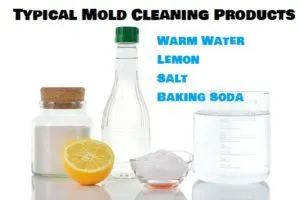
Some people don’t want to use a premade product to remove the mold of their canvas tent, which is something I can understand. So there are several DIY products that you can use to get rid of mildew from your not only your canvas tent but for most other types of canvas as well.
One of the easiest DIY products you can use to clean your canvas tent is the one I mentioned up above. This do-it-yourself mold remover is the one I find the most reliable, which is warm water, lemon, and salt. This is one of the easiest and most efficient ways I’ve found when it comes to killing mold on a canvas tent.
Another solution you can use is 1 cup of water and combine it with a quarter of a cup of white vinegar. You will want to mix this in some kind of spray bottle and give it a good shake. You will want to spray this onto the infected area and let it sit for a few minutes before giving it a light scrubbing.
The last DIY solution that is something that you can consider is combing rubbing alcohol and water together. You want to mix these together in equal parts in a small container. The next step is to get a rag and dampen it in the solution and rub the canvas tent down. After you’ve done that, you will want to rinse it with cold water and let it sit for an entire day.
These are the most common DIY solutions you will find that I believe actually work. I prefer the first method compared to the others, with the rubbing alcohol being my least favorite. It requires more work then the others, and I do always worry if it eats the waterproofing on the tent, so I feel obligated to put another coat of waterproofing on afterward.
Removing The Musty Smell From Canvas Tents
Removing the mildew and preventing it from happening again is great and all, but there’s something you should always as a finishing touch. The next step and often overlooked step is to remove the nasty old mold smell from your canvas tent. The smell mold can leave behind even after you’ve cleaned the canvas tent will still be there.
The first step in removing this smell from your canvas tent is to use a solution of white vinegar and warm water and spray it on the tent. You should then allow the tent to dry and air out for a bit which will help in removing the smell.
Baking soda is going to be your new best friend in this step, as you’ll be using a fair amount of it. You will sprinkle baking soda on the inside and outside of the canvas tent. The baking soda will help deodorize the tent and helps remove the old moldy smell.
Now comes the hard part, that is trying to get all the baking soda out of your tent. Removing the baking soda isn’t too difficult on the outside of the tent, but the inside can be a little tricky. If the floor of your tent detaches this will help a great deal. Some people do opt to use a vacuum cleaner and go over it lightly, which isn’t a bad idea.
Now you’ve got all the baking soda out and it’s dry you’re onto the next step. This is to rinse your canvas tent down with cold water, which I’d recommend using a watering can instead of a hose or high-pressure washer.
Time for the most critical step, which is to let your tent dry out in a dry place, that’s not on the grass. Once it’s dried, you should be good to go and pack your tent and store it like how our storing guide tells you to do so you don’t end up getting mold on your tent again!
What Not To Use On A Canvas Tent 
An overlooked topic, when it comes to cleaning a canvas tent is what you shouldn’t use. Knowing what you shouldn’t use on canvas, is just as important as what you can use. As the consequences can be just as adverse as leaving mold on your canvas tent. So learning what you shouldn’t use is something you need to know.
One thing I see a lot of people suggesting when it comes to cleaning a canvas tent is bleach. Bleach on a canvas tent is a horrible idea as it’s corrosive, which can eat away at your tent. It will either wreck your waterproofing, which will require you to put a coat on or, worse, ruin the fabric and create a hole.
Something else people recommend is things like there dishwasher detergent or clothes detergent. Again these are bad and can cause damage to the waterproofing and fabric as well.
There are two more things that I don’t recommend using, which is hot water and a high-power washer. Both of these can ruin your canvas tent and end up costing you money in the long run. As you can see canvas tents do have a few weaknesses when it comes to cleaning them. But if you treat them right, you’ll have an amazing tent for years to come.


Rose
Monday 29th of May 2023
Well without Jik the mould is still100% visible!!! Very frustrating. Surely there is a mould prevention spray that the tents should come with!!!